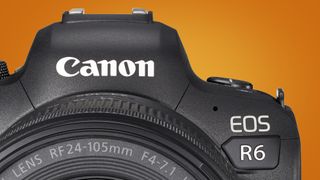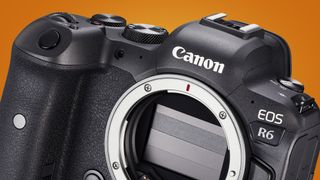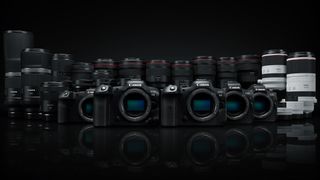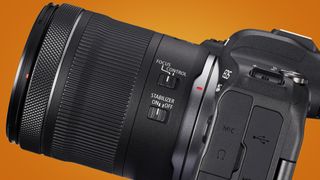Why the Canon EOS R6 could help make full-frame cameras more affordable
Opinion: The EOS R6 could be good news for bargain hunters

While this week's Canon EOS R6 and EOS R5 launch was an exciting one for camera fans, it was less thrilling for our bank accounts – whichever way you spin it, these are expensive cameras.
The R6's body-only price is $2,499 / £2,499 / AU$4,499, while the R5 is a stratospheric $3,899 / £4,199 / AU$6,899. Of course, brand new full-frame cameras have always been pricey. The Canon EOS 5D Mark IV, for example, arrived for $3,499 / £3,599 / AU$5,060 in 2016. But these aren't normal times.
Unless you're the majority shareholder in a hand sanitizer company, it's likely that some financial belt-tightening will be required this year – and that doesn't leave much room for splashing out on a new camera, let alone some accompanying RF glass.

But there's a potential upside to these sleek, shiny supercars driving onto the camera forecourt. Today's less powerful, but still very capable, EOS R mirrorless cameras should start see their prices (particularly in the second-hand market) dip, as owners flock to new models like squirrels to a sack of acorns.
And with such great value available elsewhere, new affordable full-frame models – something of a growth area, if rumors about the Nikon Z5 and Sony A5 are correct – will need to be very competitively priced, with speculation suggesting the latter could even arrive for under $1,000.
The knock-on effects of the EOS R6 and EOS R5 could give photographers some unprecedented bargains and second-hand steals. With a little patience, this year should turn out to be a great one for anyone looking to switch to a new full-frame camera.
- Read our hands-on Canon EOS R6 review
Why go full-frame?
Of course, it's always worth backing up to ask the broader question – do you really need a new full-frame camera like the Canon EOS R6?
Get daily insight, inspiration and deals in your inbox
Get the hottest deals available in your inbox plus news, reviews, opinion, analysis and more from the TechRadar team.
The fact that manufacturers are falling over themselves to launch full-frame powerhouses, which have the same size sensor as a frame of traditional 35mm film, could suggest that they're in some way 'better' than alternatives with APS-C sensors, like the Fujifilm X-T4. But that's not always the case.

The 'cropped' viewpoint of APS-C and Micro Four Thirds cameras can, for example, be a boon for wildlife and sports photography, as it lets you get the same angle of view with a smaller lens. For example, a 70-200mm lens on a full-frame camera becomes a 105-300mm lens on an APS-C model, which is ideal for wildlife snapping.
Instead, it's fair to say that the full-frame boom, which will likely see the Canon EOS R6 soon followed by the Nikon Z5 and Sony A7S III, is partly being driven by fear of the smartphone. We recently saw Olympus leave its Micro Four Thirds cameras to fend for themselves in smartphone-infested waters, while the likes of Canon and Nikon have long seen full-frame mirrorless as the safest vessel for their R&D.

This has knock-on effects for anyone who's looking to buy a camera in 2020. Because investing in a camera means buying into a system that will hopefully stick around for years or even decades – and the most likely ones to do that are relatively new mirrorless mounts like the Canon RF, Nikon Z and Sony E-Mount.
The good thing about expensive flagships like the Canon EOS R6 and Canon EOS R5 is that they tend to make these new systems more affordable for everyone else. And this will likely turn out to be true for both cameras and lenses.
Bargain hunting
For example, the Canon EOS R – the camera that the EOS R6 and EOS R5 are heavily based on – is rumored to be dropping in price to $1,499 (around £1,185 / AU$2,185, without tax) by the end of September.
While the EOS R isn't without its limitations (for example, there's only has one card slot and no AF joystick), it did launch for $2,299 / £2,349 / AU$3,250 in September 2018, making it a good option for those looking to start a future-proofed RF lens collection.
Offering even better value is the Canon EOS RP, which is currently cheaper than many APS-C cameras or even compacts like the Sony RX100 Mark VII.

How closely related is the rumored Canon EOS R price drop to the arrival of the Canon EOS R6? That's up for debate. But what's more certain is that many current EOS R owners will soon be looking to sell in order to upgrade to Canon's latest model. And that will mean even better second-hand prices for some powerful full-frame mirrorless cameras that use the same mount as the EOS R6.
Of course, it might be tempting to look at the even lower prices of full-frame DSLRs like the Canon EOS 6D Mark II. But unless you already have existing EF glass, the more future-proofed option is likely to go for RF mount options like the Canon EOS R or Canon EOS RP.

Another promising development from the Canon EOS R6 launch was the arrival of some better-value RF lenses. For the non-professional shooters out there, the Canon RF 85mm f/2 Macro IS STM ($599 / £650, around AU$1,180) looks a solid new option for macros and portraits.
And then there's that pair of slightly eccentric, but well-priced, ultra-telephotos: the Canon RF 600mm f/11 IS STM ($699 / £750, around AU$1,360) and RF 800mm f/11 IS STM ($899 / £980 (around AU$1,775).
Granted, the f/11 apertures of these wildlife and sports lenses might have been designed with the high ISO performance of the Canon EOS R6 and EOS R5 in mind. But it's great to see more RF lens options for hobbyist photographers.
- These are the best full-frame mirrorless cameras in the world right now
Full-frame for less
While it's true that early adopters of shiny new releases like the Canon EOS R6 have always helped subsidize tech for the rest of us, this is particularly the case with today's full-frame cameras.
The competition between Canon, Nikon, Sony and Panasonic is white-hot, and full-frame is becoming increasingly popular among hobbyist photographers. This is partly due to traditional advantages, like full-frame's ability to offer higher resolution, wider dynamic range and shallower depth of field.

But it's also because, just like the latest smartphones, today's powerful processors are removing some of full-frame's traditional limitations, like burst shooting speeds, video resolution and body size.
The final barrier is price. With new models like the Canon EOS R6 putting extra pressure on more affordable full-frame cameras, and encouraging the growth of an RF lens system with more widespread appeal, it could soon become a great year to switch to full-frame mirrorless. Even if you don't start with the very latest cameras.
- These are the best cameras you can buy right now

Mark is TechRadar's Senior news editor. Having worked in tech journalism for a ludicrous 17 years, Mark is now attempting to break the world record for the number of camera bags hoarded by one person. He was previously Cameras Editor at both TechRadar and Trusted Reviews, Acting editor on Stuff.tv, as well as Features editor and Reviews editor on Stuff magazine. As a freelancer, he's contributed to titles including The Sunday Times, FourFourTwo and Arena. And in a former life, he also won The Daily Telegraph's Young Sportswriter of the Year. But that was before he discovered the strange joys of getting up at 4am for a photo shoot in London's Square Mile.
Most Popular

